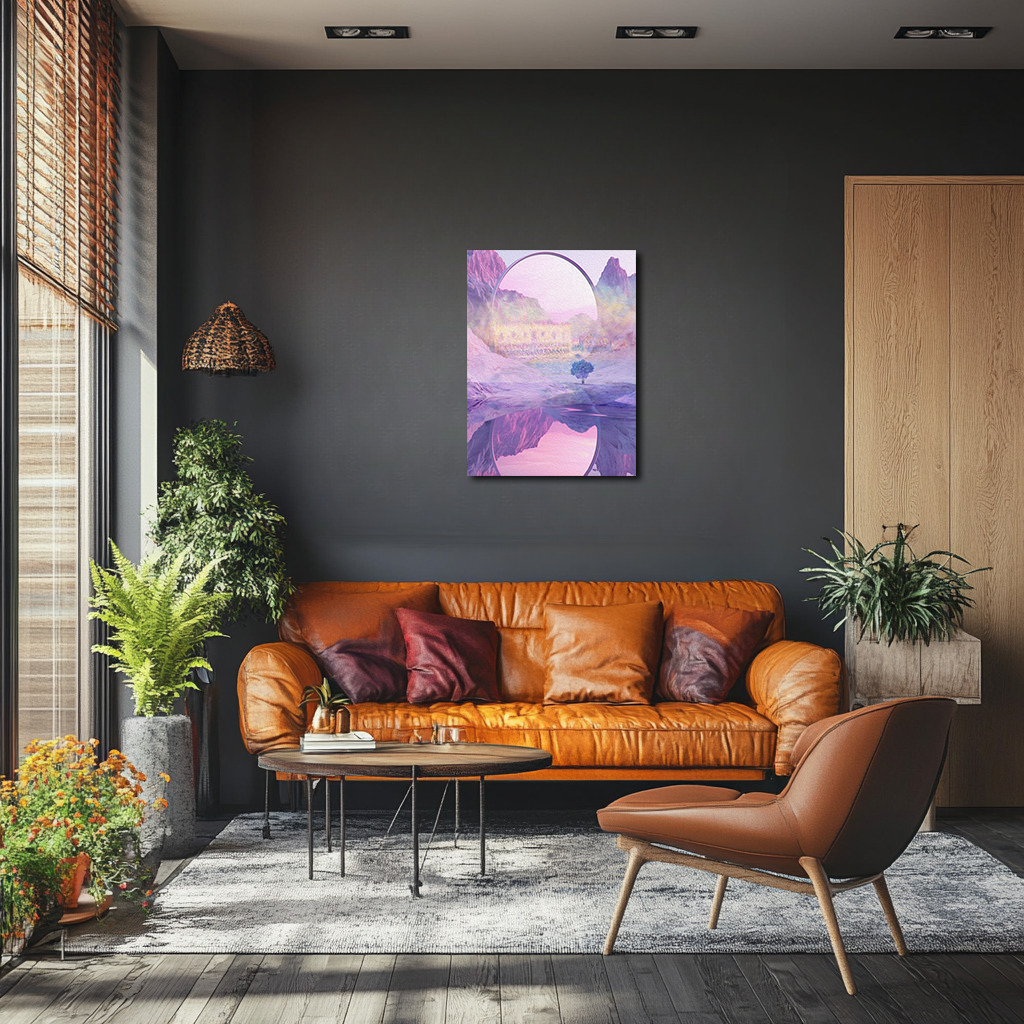Reflection of Dreams: The Palace Within the Mirrored Horizon
This conceptual reinterpretation of Claude Monet’s The Doge’s Palace Seen from San Giorgio Maggiore (1908) places the palace within a dreamlike, reflective landscape. Framed by an ethereal, circular portal, the architecture floats gently above pastel-hued hills and mirrored waters, illustrating perception as fluid and transcendent. The solitary tree signifies human contemplation amid infinite possibility, blending reality and imagination into one luminous vision. This piece captures Monet’s fascination with the shifting effects of light and water, inviting viewers into a meditative exploration of perception and consciousness, where physical and emotional realities endlessly reflect and reshape one another.
Please see Below for Details…
Hotline Order:
Mon - Fri: 07AM - 06PM
404-872-4663
Claude Monet’s The Doge’s Palace Seen from San Giorgio Maggiore (1908) embodies more than a painterly depiction of Venice’s iconic architecture—it is an exploration of the transient interplay between color, water, and light. Monet was enchanted by the ephemeral beauty of Venice, repeatedly attempting to capture not merely its structures but their fleeting reflections on the shifting surface of the lagoon. In doing so, Monet transformed an architectural marvel into a poetic meditation on impermanence, using fluid brushstrokes and soft, luminous hues that seem to dissolve solid form into delicate ripples and vibrant illusions of color.
This conceptual reinterpretation expands Monet’s visual poetry, turning his gentle exploration into a profound allegory of reflection, mirroring, and inner contemplation. Here, the palace does not merely exist as architecture; it appears suspended within a surreal and dreamlike landscape, encased in an ethereal, circular portal. The scene is bathed in subtle pastels, lilacs, gentle pinks, and blues that softly diffuse the boundaries between reality and imagination, creating an atmosphere of dreamlike serenity and boundless contemplation.
At the heart of this reimagined composition lies the iconic facade of Monet’s palace, delicately shimmering and almost ghostly in appearance, surrounded by a halo of soft light. The palace facade, blurred by the nuanced gradations of Monet’s palette, seems simultaneously tangible and intangible, a vision hovering in a liminal space. Its form, gently distorted by waves of radiance and reflection, no longer stands on solid ground but floats within a luminous circle, an emblematic window bridging reality and imagination.
In the foreground, an isolated, solitary tree stands in quiet dignity, appearing to anchor the composition gently yet powerfully. Its presence is modest yet significant, symbolizing resilience, life, and contemplation amid surreal surroundings. The tree's reflective presence on the water beneath doubles its image, enhancing the overall impression of symmetry and mirroring, further emphasizing the duality and interconnectedness between physical reality and inner perception. This visual echo creates a subtle emotional resonance, inviting the viewer into introspection about their relationship with nature, time, and consciousness.
The surrounding landscape is soft, undulating, and abstractly rendered, formed from gentle hills and smooth terrain, each stroke carrying Monet’s legacy of delicate expressionism. This surreal geography frames and cradles the palace and its reflection, enhancing the dream-like quality of the entire composition. The gentle colors and reflective surfaces evoke tranquility and peace yet are tinged with a wistful sense of longing, evoking the way memories and experiences echo within our consciousness, reshaped by time and emotion.
The mirror-like surface of water extends from the circle toward the viewer, suggesting that reality itself is merely a reflection of our perceptions and internal states. The landscape's reflection, inverted yet harmonious, symbolizes how human consciousness constantly reshapes and reinterprets reality, transforming solid experience into a fluid, ever-changing narrative. The image, with its ethereal and fluid brushwork, captures not simply the reflection of physical surroundings but the deeper, emotional reflections each person carries within themselves.
In this artwork, my intention was to delve deeper into Monet’s thematic explorations, creating a narrative that speaks to both external reality and internal experience. Monet’s Venice series, originally driven by his fascination with the transient effects of light on architecture and water, inspired this piece's conceptual expansion into a meditation on consciousness itself. The circular portal symbolizes human perception—both a barrier and an opening, framing reality as something infinitely malleable and profoundly beautiful.
My reinterpretation aims to express a feeling of quiet contemplation, of standing at the threshold between worlds, recognizing our fleeting presence within a much grander continuum of existence. This piece explores how the tangible and intangible, external reality and internal reflection, exist side by side, deeply intertwined. The scene is peaceful yet charged with an underlying sense of wonder, mystery, and longing—emotions Monet himself experienced while capturing Venice's elusive beauty.
In essence, this conceptual reinterpretation of Monet's Venetian study is about the act of seeing and feeling. It visualizes how perception is a creative act, a continuous interplay between the external world and our inner lives. The palace, suspended between landscape and reflection, between reality and imagination, represents not merely a historic structure, but humanity’s ceaseless quest to find deeper meaning and beauty within ephemeral experiences. It acknowledges the endless fluidity of reality and invites us to accept the transformative power inherent within our own perceptions.
Through this artwork, I aimed to create a profound dialogue between viewer and image, an intimate exploration of perception’s beauty and complexity. Like Monet’s original work, this composition evokes the profound sensation of observing the ephemeral and attempting to hold onto its fleeting essence. It is a testament to the power of art to shift our awareness, to encourage us to look not only outward at the world around us but inward to the landscapes of our own emotional and cognitive realities.
Thus, the work becomes more than mere homage—it is an emotional journey, an exploration of perception's dual nature as both gateway and reflection. It emphasizes the beauty within uncertainty, the peace within ambiguity, and the infinite potential for beauty in the ordinary world as seen through imaginative eyes.
Add your review
Your email address will not be published. Required fields are marked *
Please login to write review!
Looks like there are no reviews yet.








